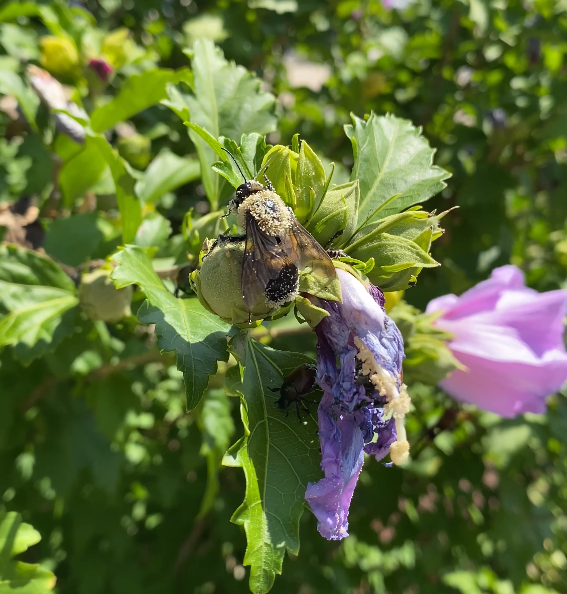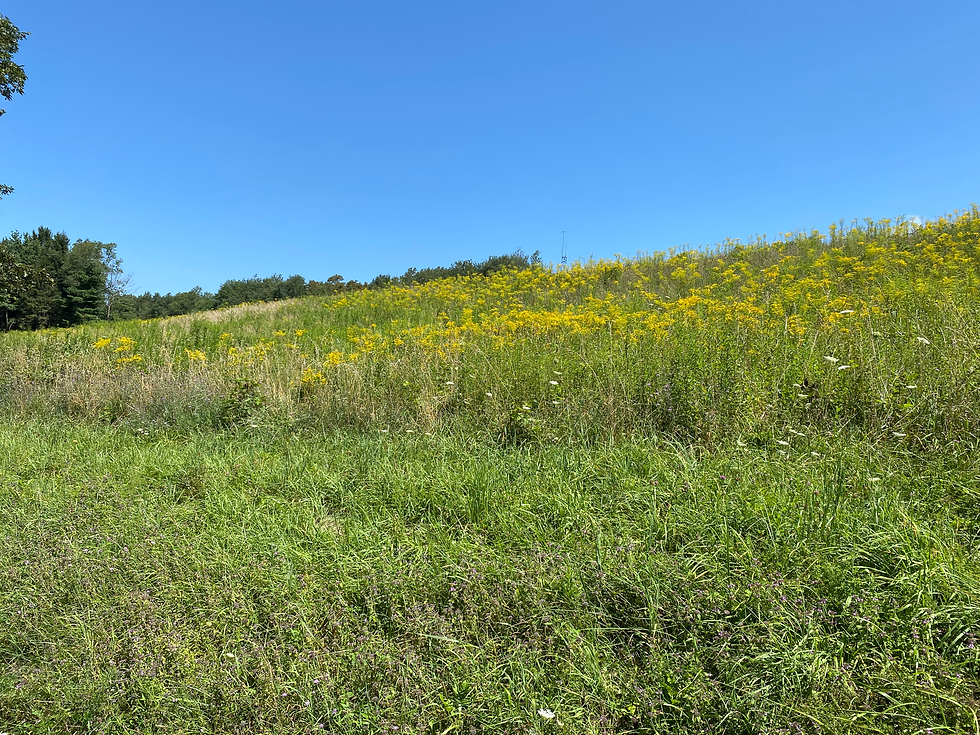Beekeeping in Different Climates: Nevada Desert vs. Maryland Forest
- Pete Rizzo

- Aug 14
- 6 min read
Updated: Aug 22

Key Points:
Maryland’s humid, forested environment creates a very different beekeeping landscape than Las Vegas’s dry desert.
Pollinator populations differ: Maryland has abundant wasps, bumblebees, carpenter bees, and butterflies; honeybees are less common in the wild.
Late-summer blooms, like aster and goldenrod, are critical forage for pollinators preparing for fall.
Exploring Maryland’s Lush Beekeeping Landscape
In early August of 2025, Betsy and I traveled across Maryland to see firsthand what beekeeping looked like on the other side of the country.
Coming from the desert climate of Las Vegas, we were immediately struck by just how green Maryland is. It’s a state of thick forests and a constant presence of running water.

Streams, ponds, lakes, rivers, and swamps weave through the landscape, creating a lush environment that couldn’t be more different from home. Plus they have bears! Sorry, I had to add that in somewhere.
Maryland’s Pollinators Are a Diverse Mix Beyond Honeybees
With so much moisture and vegetation, it’s no surprise that the pollinator makeup here is completely different too.
We noticed right away that honeybees were actually the least common pollinator we saw. How could this bee?

Well, Maryland is way different from Las Vegas. They have a huge variety of wasps, hornets, carpenter bees, bumblebees, and an impressive number of butterflies.
The wasps, in particular, were everywhere, often hovering under the eaves of homes and businesses. At first, their numbers seemed excessive, but in a place that’s essentially a giant forest, it makes sense.

Wasps are carnivores, and with an abundance of insects to feed on, they thrive. We even got a close up view of a yellow jacket munching a small green bug, possibly a beetle. We aren't sure as we got closer, the yellow jacket flew off with it's prize.
Learning from Maryland Beekeepers:
During our trip, we had the chance to meet and talk on the phone with a few Maryland beekeepers. They welcomed us, showed off their hives, and shared both the challenges and successes of their work.

They spoke about how humidity, abundant rain, sometimes drought, a longer bloom season, and competition from other pollinators all play a role in Maryland beekeeping.
However, the fundamentals are the same: strong queens, good forage, and healthy colonies are the keys to success no matter where you keep bees.
It was clear that while the fundamentals of beekeeping remain the same, the experience of keeping bees here is shaped by an entirely different set of conditions than what we face in Nevada.

We also visited farms and saw vast fields of corn, sunflowers, and soybeans. Soybeans are mostly self-pollinating, but research shows honeybees will work soybean flowers for nectar, and their activity can improve yields.
Some Ohio-based research found bees using soybean fields as a significant pollen source. Bees also bring back nectar from soybeans, meaning beekeepers sometimes harvest honey that includes soybean pollen.
We never checked in the fields, other than the sunflowers; so we don't know any of this firsthand.

Beekeeping in Las Vegas vs. Maryland – 2025 Observations
Category | Las Vegas, Nevada | Maryland |
Climate | Arid desert, very low humidity, hot summers, mild winters. | Humid, four distinct seasons, cold winters, hot summers. |
Landscape | Sparse vegetation, limited natural forage, irrigation-dependent blooms. | Dense forests, abundant natural water sources (streams, ponds, lakes, rivers). |
Main Pollinators Observed | Honeybees, some native solitary bees, few butterflies. | Wasps (several kinds), carpenter bees, bumblebees, butterflies, some honeybees (least observed). |
Honeybee Abundance | Common in managed hives, frequent in urban forage zones. | Lower presence in the wild; competition from other pollinators. |
Wasp Presence | Moderate, mostly paper wasps. We have seen one or two small yellow jacket nests in summers. | High, around home and business eaves; High in natural settings. Large insect population supports them. |
Agriculture | Limited crop variety; small urban gardens and some irrigated farms. | Extensive farmland with major crops including corn and soybeans. |
Pollination Value of Main Crops | N/A. Desert agriculture relies on specialty crops (melons, squash, alfalfa). | Corn: wind-pollinated, no bee value. Soybeans: self-pollinating but bees will forage for nectar; bee presence can improve yields. |
Forage Sources | Ornamental plantings, irrigated landscapes, seasonal desert blooms. | Diverse wildflowers, forest trees, agricultural crops, and many home managed gardens. |
Beekeeping Challenges | Extreme summer heat, drought, limited forage periods. Water and shade issues in the summer. | High humidity and excessive rain, longer bloom season but more competition from other pollinators. Overwintering in cold. |
Beekeeping Similarities | Strong queens, healthy colonies, pest and disease management are critical in both locations. | Same fundamentals apply despite different environmental pressures. |
Late-Summer Blooms of Aster and Goldenrod in Maryland
In the middle of August, aster and goldenrod were in full bloom. Depending where we were visiting, some were just beginning to bloom. Black eyed Susans were in the same boat as were coneflowers. We noticed an abundance of Queen Anne's Lace, clover, and live forever plants blooming.

These late-summer flowers are critical for pollinators at this time of year. Bumblebees, carpenter bees, and butterflies were actively visiting the blooms, while honeybees were fewer in number, but still foraging with the others.
Asters and goldenrod provide important nectar and pollen sources that help pollinators build up energy before the fall, and they were clearly a major part of the local forage landscape. Plus they are so beautiful and their colors added a lot of beauty to all the green around them.

Reflections on Maryland Hives and Pollinators
As we left Maryland, it was clear how much the environment shapes both the bees and the beekeeping experience. The mix of forests, farmland, and abundant late-summer blooms creates a very different world from the desert conditions we manage in Las Vegas.

Seeing the variety of pollinators, the role of late-season flowers, and the challenges local beekeepers face gave us a deeper understanding of how climate, forage, and landscape affect hive health and management.

The trip reinforced that, no matter where you keep bees, observing and adapting to your environment is essential for success.
We did suggest Beekeepers use insulation on their hives as well. Maryland has very hot, humid summers and cold winters, so their hives would benefit from insulation just as we do here in Las Vegas and Arizona.

A big thank you to all of the Pratt Family Members we ran into, Jerry Rice, and Truman. We really appreciate your kindness and hospitality.
Betsy & Pete
About Us: The Authors

We’re Betsy and Pete - Beekeepers on a Mission in Las Vegas
We’re not just in the bee business, we’re in the bee-saving business. Trained by a master beekeeper and backed by hundreds of successful removals, we are dedicated to rescuing and relocating honey bees with care and precision.
Every swarm we save and every hive we manage reflects our deep love for the bees.
At our Joshua Tree Preserve in Arizona, we care for dozens of thriving hives. Some wild, some honey-bearing, and all are part of our commitment to ethical, sustainable beekeeping.
Why Vegas Bees? Because We Never Stop Learning or Caring
Beekeeping is always evolving, and so are we. We stay on the cutting edge by continuing our education, connecting with fellow beekeepers, and refining our beekeeping practices and techniques to ensure the best outcomes for both bees and people.
Whether it’s advanced bee removal strategies or the latest natural methods, we’re always one step ahead.
We’re also proud to support the beekeeping community with high-quality beekeeping supplies for everyone. If you’re ready to suit up and start your journey, we’ve got what you need.
.png)


